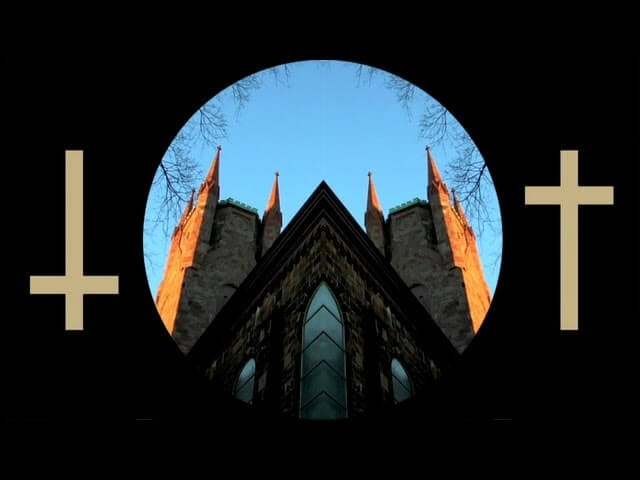
Liturgy, a Brooklyn-based black metal band who released its sophomore album, Aesthetica, earlier this year on Thrill Jockey, has been a source of controversy in the metal world. The metal police have given the band a hard time for where its members are from and how they dress—that’d respectively be Brooklyn, and like… well, you-know-whats. (They’ve been mocked as “hipster-metal.”)
You could chalk this up in part to how Liturgy has managed to get some pretty significant press from mainstream publications (The New York Times and The New Yorker, to name just two) that never before dared to write anything about black metal, one of metal’s most feared, brutal, bleak, and gory subcategories.
But the deep-set anti-Liturgy arguments come from a book called Hideous Gnosis: Black Metal Theory Symposium I. Back in 2009, Liturgy frontman Hunter Hunt-Hendrix organized the first Black Metal Theory Symposium (in Williamsburg) to investigate black metal from the perspective of academic philosophy and critical theory. It spawned Hideous Gnosis, a collection of essays by symposium participants, including Hunt-Hendrix’s contribution, “Transcendental Black Metal: A Vision of Apocalyptic Humanism.” In it, the Columbia graduate argues that a radical break must happen between European (Hyperborean) Black Metal and Transcendental Black Metal—the latter being identified by a renewed celebratory and active spirit, as opposed to the passive nihilism of the old black metal guard. It’s basically a manifesto for Liturgy, the harbingers of this new black-metal movement… or whatever it is.
If the first word that comes to your mind is “pretentious,” then you’re on the same page as Hunt-Hendrix’s critics. As Chris Grigg, a member of Philadelphia-based metal band Woe, wrote in an open letter to Hunt-Hendrix, “We get it, dude. You think you are very, very important. Everything about you oozes a sense of superiority… Who the fuck are you to dictate anything about black metal in a way that affects anyone other than yourself? Your experience as a philosophy student at Columbia does not grant you the title of President of Black Metal.”
Everybody can get behind a good black-metal philosophy squabble, so you can read Hunt-Hendrix’s response to Grigg at Stereogum and most of Hunt-Hendrix’s infamous quasi-Nietzschean essay at Vice.
Is Liturgy the future of black metal? Will Liturgy’s music determine the course of human history? Was Nietzsche insightful, or insane? You can find out tonight, when Liturgy plays Kung Fu Necktie. We caught up with Hunt-Hendrix via email to ask a few follow-up questions about “Transcendental Black Metal,” and, as you’ll soon discover, his answers have left us scratching our collective head even more than before.
The A.V. Club: I just finished reading Hideous Gnosis: Black Metal Theory Symposium I, and one thing stood out as being very peculiar: The font of your essay, “Transcendental Black Metal: A Vision of Apocalyptic Humanism,” is different from the fonts for all the other essays. Why?
Hunter Hunt-Hendrix: The essay has to be in Arial, it doesn’t work in any other font.
AVC: Can you explain the technical differences between the blast beat and the burst beat?
HHH: The burst beat is sort of a regulative concept like “freedom” or “equality.” It is impossible to satisfy, but basically it amounts to a tempo both accelerating and staying the same.
AVC: Is it used on Aesthetica?
HHH: Yes, but not always. It’s used on “Returner.”
AVC: What does the introduction of the burst beat entail for black metal?
HHH: The burst beat resonates with life throbbing beneath a dead husk.
AVC: When you write in the essay that the mode of Transcendental Black Metal is sacrifice, what are you talking about?
HHH: Ultimately, everything sacrifices itself, destroys itself by mean of it’s own fruition. Just look at Christianity or Western culture.
AVC: You write that “Black Metal is only the tip of an iceberg at the base of which is hidden a new relationship between art, politics, ethics, and religion.” Can you talk about this—namely what’s down there at the base?
HHH: At the base of the iceberg is the Arkwork. I’m working on a new piece defining the Arkwork and it’s [sic] relationship to Aesthethica. It has a lot to do with the idea of the gesamtkunstwerk (from Wagner to Beuys) and also with the ancient identification of the True, the Good and the Beautiful. Nietzsche rejected this identification, but, as big an influence as he is on what I do, on this point I cannot agree.
AVC: What’s the difference between Aesthetics and Counterculture?
HHH: Counterculture opened up in the 1960s, but its first seed was William Blake. Aesthethics is like counterculture but with no reference to any enemies. There is a “yes” to Ginsberg-era counterculture that has really faded with time. Aesthethics has to do with this “yes.”
AVC: You claim that Transcendental Black Metal is the reanimation of black metal with a new soul. What does that mean?
HHH: C.S. Lewis once said you never get anywhere by trying to be original. You have to just aim at Truth and the rest happens on its own.
AVC: Do you see yourself, and Liturgy, as pushing toward these goals? Are there any other bands who are doing so?
HHH: Yes. There are other bands, too. Genesis P-Orridge, maybe.
AVC: Are bands who aren’t creating Transcendental Black Metal your enemies?
HHH: [Laughs.] Of course they’re not enemies! Ultimately, the essay is just a proposal based on a particular outlook. Plus, I think most black metal bands do make transcendental black metal, and at any rate, Liturgy definitely makes hyperborean black metal. It’s like two poles.